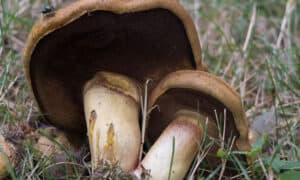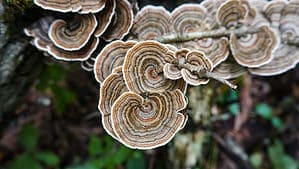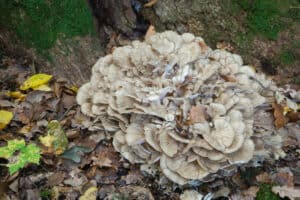While purple mushrooms aren’t particularly common, they are an absolute delight to come across on strolls through the forest. Typically, these colorful, whimsical mushrooms are the most vivid and striking when young, as their lovely purple coloration often fades with age and weathering.
In this guide, we’ll take a look at three types of purple mushrooms, where they grow, their morphological features, ecological roles, and edibility status.
Read on to learn more!
1. Types of Purple Mushrooms: Violet Webcap (Cortinarius violaceus)
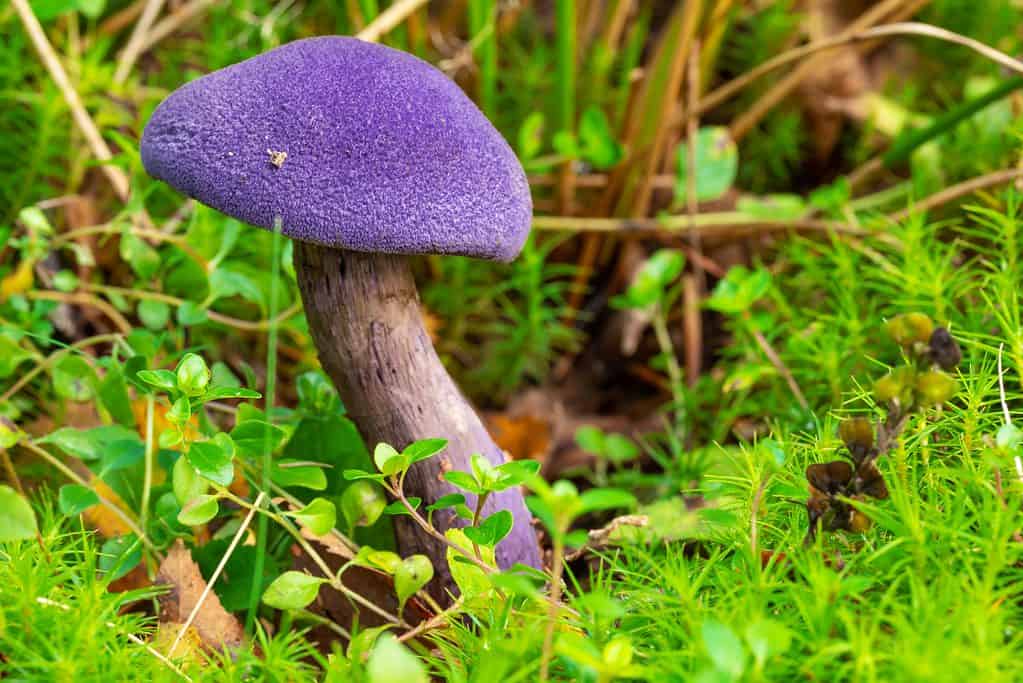
is eaten by some people, but few, if anyone, consider it a choice edible.
©Phant/Shutterstock.com
When young and fresh, the violet webcap (Cortinarius violaceus) is a stunning mushroom with vibrant purple gills, cap, and stem (aka stipe). This lovely mushroom occurs across temperate forests of North America, Europe, and Asia. In the British Isles, this species is endangered. It also occasionally grows in the subarctic regions of western Greenland.
Identification
It’s important to note that Cortinarius violaceus does not retain its purple coloration throughout the entirety of its life cycle. Aged specimens are often mostly brown with some purple streaks. This species is much easier to identify when it is immature to mature recently.
Cap
Immature Cortinarius violaceus specimens have convex-shaped caps. As it grows, the cap expands to broadly convex, almost flat, or slightly bell-shaped. Before it becomes aged, the cap is a lovely violet color. Sometimes, the cap is covered in dense fine hairs, giving it a fuzzy/scaley texture. The cap may grow up to about 5 inches in diameter. Markedly aged specimens typically feature a dark brown cap that may have hints of purple. The flesh throughout is purple to purplish gray on mature specimens.
Gills
When young, the gills are dark violet. The gills of immature specimens are covered by a purple, web-like partial veil, which is called a cortina. This veil breaks as the cap expands. The gills become purplish gray and eventually rusty brown as the spores mature. The spore print is rusty brown. The gills aren’t crowded and typically feature short gills in between the ones that run from the underside of the cap margin to the stipe.
Stipe
Like the rest of this lovely mushroom, when young, the stipe is purple and often covered in fine hairs. Mature specimens feature brown to brown-black stripes that are nearly hollow. It can measure up to 6 inches tall and reach about .75 inches thick. The base of the stipe is typically swollen.
Ecology
The violet webcap is a mycorrhizal species. This means the filamentous, underground portion of the fungus (the mycelium) engages in a mutually beneficial nutrient exchange with the roots of host trees. Cortinarius violaceus is associated with a range of both hardwood and conifer trees. This species fruits in fall either alone, scattered, or abundantly across the forest floor.
Edibility
Field guide claims on the edibility of Cortinarius violaceus vary. Additionally, some webcaps are quite toxic. As such, we do not recommend consumption.
2. Types of Purple Mushrooms: Amethyst Deceiver (Laccaria amethystina)
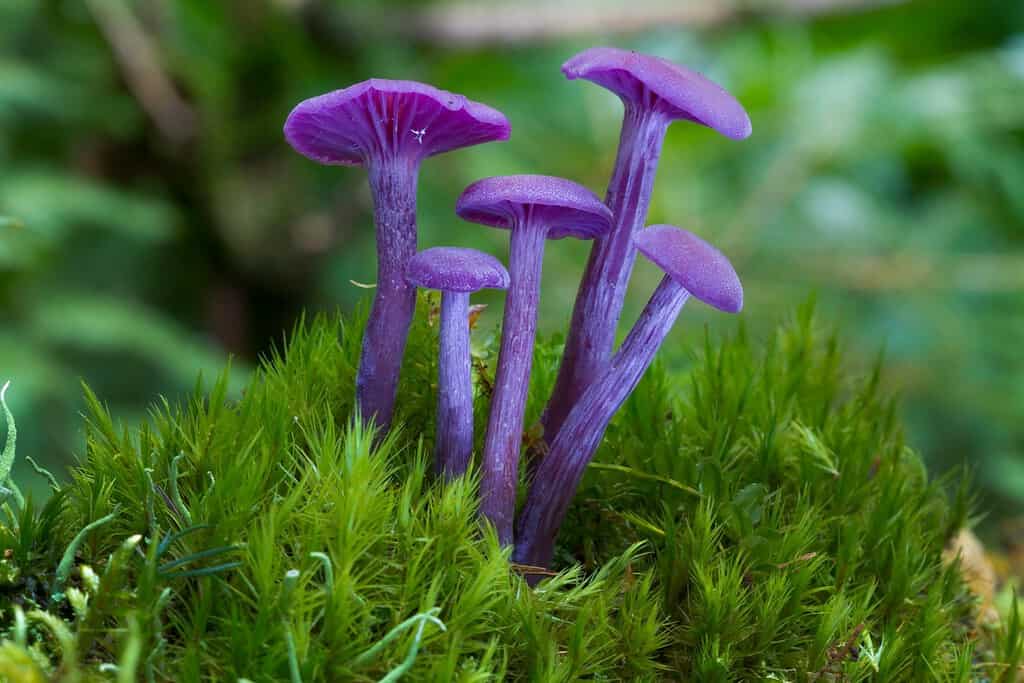
©godi photo/Shutterstock.com
Quite distinctive and beautiful when young, the amethyst deceiver (Laccaria amethystina) produces enchanting amethyst purple fruiting bodies. Laccaria amethystina commonly occurs in temperate forested regions across Asia, northern South America, Central America, eastern North America, and Europe.
Identification
As this gilled, cap-and-stipe mushroom matures, dries out, or endures weathering, it turns cream-to-brown color. The common name of “deceiver” refers to the difficulty in identifying mature or weathered specimens that have lost their vibrant amethyst coloration.
Cap
Initially convex with in-rolled margins, the purple cap expands to a broadly convex or flat shape. The margins may have pale striations. Many display a central depression, and some older specimens may feature upturned margins. At maturity, the cap may grow up to a little over 2 inches in diameter. The flesh is thin and pale, purplish gray.
Gills
Fresh, non-aged individuals display lovely dark purple gills. The gills are waxy, spaced distantly apart, broad, sometimes wavy, and interspersed with short gills. The gills typically lose their strikingly purple color before the cap in response to the maturing spores, which produce a white spore print.
Stipe
The stipe is rarely fully purple, even when young. Instead, it often features patches of purplish gray to purplish brown. The stipe is typically equal in thickness except for a slightly swollen base. It can measure up to about 3 inches in height. The stipe is hollow and fibrous.
Ecology
In North America, Laccaria amethystina only occurs east of the Rocky Mountains. What broad categories of tree this species is mycorrhizal with depends on its growing region. In North America, the amethyst deceiver fruits are from late spring through summer and can primarily be found with hardwoods, especially beeches. Additionally, a 2001 study confirmed L. amethystina to be an “ammonia fungus,” a species that develops fruiting bodies in abundance after neutral or weakly alkaline soil is amended with ammonium-nitrogen.
Edibility
This species is technically edible. However, the stipe is fibrous, the flesh is thin, and not particularly flavorful. The amethyst deceiver is also similar looking to a couple of other poisonous purple mushrooms.
Additionally, researchers have found that Laccaria amethystina may contain harmful levels of elemental arsenic in contaminated soils compared to several other mushroom species growing in the same soil. This suggests a hyperaccumulation of arsenic by L. amethystina. Given its less-than-stellar flavor profile and potential for hyperaccumulation of arsenic, consumption is not recommended.
3. Types of Purple Mushrooms: Lilac Fibrecap (Inocybe lilacina)
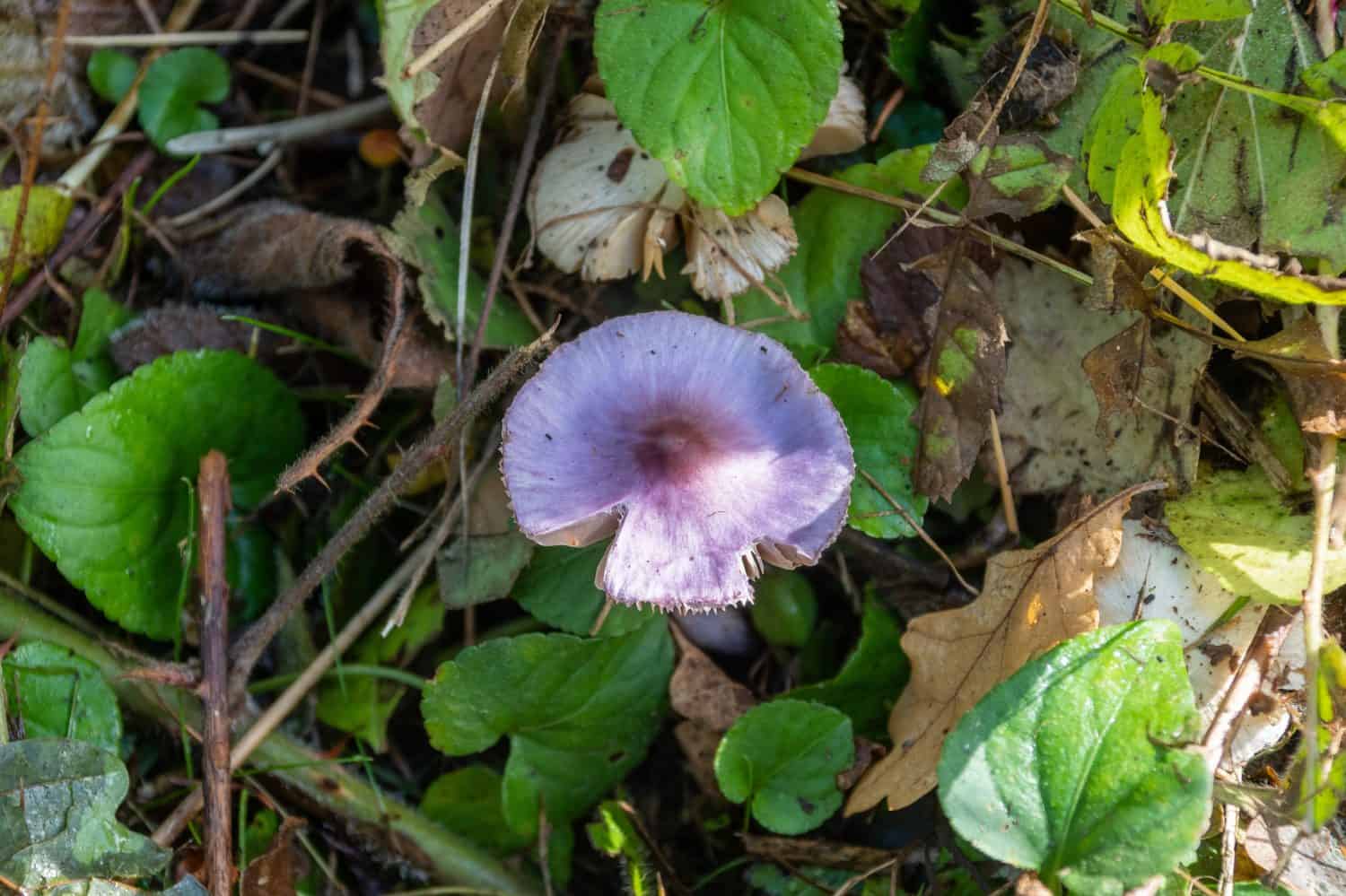
This beautiful mushroom contains a toxin that is especially toxic to canines.
©Starsphinx/Shutterstock.com
Commonly occurring across North America and mainland Europe, the lilac fibrecap (Inocybe lilacina) is a lovely mushroom to stumble across on a forest stroll.
Identification
This light purple species is perhaps one of the most colorful of the approximately 1000+ species in the Inocybe genus. Like many other purple-colored mushroom species, Inocybe lilacina tends to lose its distinctive and lovely purple coloration with age and consistent exposure to direct sunlight. When young and fresh, however, the fruiting body is a delightful, gentle lilac.
Cap
The cap of an immature lilac fibrecap is conical. As the mushroom matures, the cap expands to broadly bell-shaped. The caps of young specimens are a beautiful lilac, although they may also feature patches of pale pink or cream. As the cap ages, the color tends to fade to a pinkish or pale purplish-brown. Caps of very old specimens or those exposed to direct sunlight often fade to nearly white. The cap may measure up to 1.5 inches in diameter. The flesh is lilac to off-white.
Gills
The gills of Inocybe lilacina crowd, initially pale purplish-gray-brown and narrowly attached to the stipe. As the spores mature, the gills become light brown and produce a brown spore print. The gills of Immature specimens are covered by a white, cobweb-like partial veil called a cortina.
Stipe
The stipe is faintly lilac to off-white with an equal or swollen base. Sometimes, fine hairs cover it, and a faint partial veil ring may be present. The stipe may measure up to about 3 inches tall.
Ecology
Inocybe lilacina is mycorrhizal with hardwoods and conifers. You may find it growing solo, scattered, or abundantly across the forest floor. Depending on the growing region of North America, it may fruit from late fall through early winter.
Edibility
The lilac fibrecap is quite poisonous and contains toxic levels of muscarine. While lovely to gaze upon, when ingested, this species can cause significant nerve toxicity with symptoms including:
- Tremors
- Low blood pressure (hypotension)
- Blurred vision
- Restlessness
- Fainting
- Increased or decreased heart rate (tachycardia and bradycardia)
- Hypersalivation
- GI pain
- Vomiting
- Diarrhea
- Sweating
- Seizures
The photo featured at the top of this post is © Phant/Shutterstock.com
The information presented on or through the Website is made available solely for general informational purposes. We do not warrant the accuracy, completeness, or usefulness of this information. Any reliance you place on such information is strictly at your own risk. We disclaim all liability and responsibility arising from any reliance placed on such materials by you or any other visitor to the Website, or by anyone who may be informed of any of its contents. None of the statements or claims on the Website should be taken as medical advice, health advice, or as confirmation that a plant, fungus, or other item is safe for consumption or will provide any health benefits. Anyone considering the health benefits of particular plant, fungus, or other item should first consult with a doctor or other medical professional. The statements made within this Website have not been evaluated by the Food and Drug Administration. These statements are not intended to diagnose, treat, cure or prevent any disease.
Thank you for reading! Have some feedback for us? Contact the AZ Animals editorial team.




